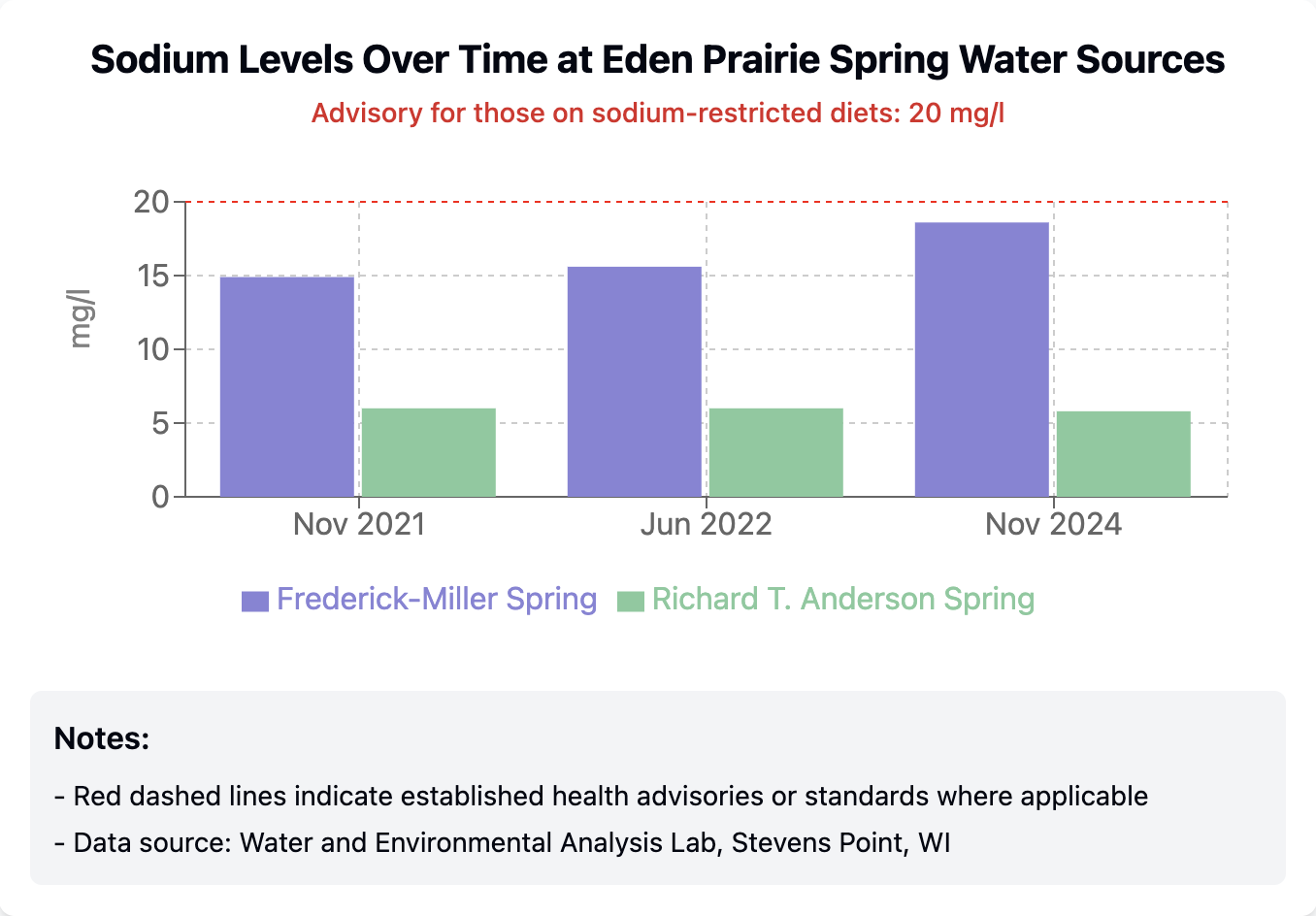Eden Prairie Springs: Natural Resources for Community Wellness
Key Findings
This report compares water quality between Eden Prairie's two natural springs. Frederick-Miller Spring has better drinking water with healthy calcium and magnesium levels while keeping harmful substances well below EPA limits. However, Richard T. Anderson Spring shows worrying levels of manganese (above EPA safety guidelines) and arsenic (meeting or exceeding EPA limits). These findings matter for community health, especially for pregnant women, children, and older adults who drink this water regularly.
Why This Testing Matters
People filling up by the gallon at the Frederick-Miller Spring.
As a local resident and naturopathic doctor, I began this investigation because testing data was limited and many people incorrectly believe Eden Prairie tests spring water quality beyond bacteria.[1,2] In reality, mineral analysis has been lacking, despite increasing community interest in consuming these waters for health benefits.[2] Many of my patients and other community members regularly collect and drink from these springs without understanding their different mineral profiles and the potential impact to their health.
Two Distinct Natural Resources
Eden Prairie is home to two natural springs that community members use for drinking water. The Frederick-Miller Spring (FMS) and Richard T. Anderson Spring (RTAS) have different mineral profiles that can impact your health. I got into this as a local interested resident who drinks the water and sees many others doing the same. I have also noticed an increasing interest in drinking this water for health benefits. While testing the water for mineral differences, I've spoken with many interested Minnesotans. I am excited to share the new test results that I have collected since 2021 comparing the mineral content of these two springs.
Understanding the Mineral Profiles
My testing shows important differences between the FMS and the RTAS. The FMS contains higher levels of calcium (103.97 mg/l vs. 94.50 mg/l, p=0.0195) and magnesium (36.87 mg/l vs. 32.90 mg/l, p=0.0143). Calcium and magnesium are essential minerals your body needs to function. These minerals work together to keep you alive, pumping blood from your heart and firing off action potentials in your brain. Calcium is notable for building strong bones and magnesium is notable for increasing tolerance to stress. Overall, the FMS is a mineral powerhouse that provides an excellent source of calcium and magnesium to support your health.
On the other hand, the RTAS contains much higher levels of manganese (0.33 mg/l vs. 0.00 mg/l, p<0.0001) and arsenic (0.0118 mg/l vs. 0.0043 mg/l, p<0.02). Arsenic and manganese in drinking water are both significant health concerns. The differences in arsenic content is an important consideration, as the RTAS levels approach or exceed the EPA safety threshold of 0.01 mg/l, while FMS maintains levels well below this limit.[3] The manganese level of the RTAS tested consistently above the EPA health advisory limit of 0.3 mg/l in three different tests across seasons and years.[4] Review the charts and tables in the slideshow below for a deeper look at the data.






Frederick-Miller Spring: Benefits and Safety Profile
Frederick-Miller Spring
This spring offers several health advantages. The relatively high calcium and magnesium levels pair with very low levels of arsenic and lead. Very sensitive testing shows extremely low arsenic levels (as low as 0.0008 mg/l), far below the EPA threshold, and lead levels below 0.0002 mg/l.
For people looking to gain the health benefits of mineral rich spring water, water from the FMS is an excellent resource. While sodium levels have gradually increased from 15 mg/l to nearly 19 mg/l, they remain below advisory levels for most people. I know many patients who drink mineral depleted reverse osmosis filtered water that would benefit from mixing in some high quality mineral water to maintain electrolyte balance in their body. Overall, the FMS is a great choice for Minnesotans looking to gain health benefits from drinking spring water and possibly save a few bucks on their water bills.
Richard T. Anderson Spring: Health Risk Considerations
Richard T. Anderson Conservation Area
Our testing shows patterns that should make you cautious about using RTAS regularly. The manganese levels consistently exceed the EPA health advisory limit of 0.3 mg/l across multiple tests.[4] High manganese exposure can increase dopamine breakdown in the brain, leading to lower dopamine levels.[5,6] This disruption can affect movement, mood, and thinking over time. [5,6,7] Manganese can also overwhelm the brain's natural antioxidant defenses, causing damage to brain cells through oxidative stress. [8,9,10]
Further, regular testing shows arsenic levels at the RTAS consistently approach or exceed the EPA limit of 0.01 mg/l.[3] While our most recent low-level analysis showed 0.0099 mg/l (just under the limit), most standard tests have shown levels above this threshold. According to the Minnesota Department of Health, chronic arsenic exposure through drinking water, even at levels near the legal limit, can cause multiple severe health conditions including bladder, lung, and skin cancers, while also being associated with cardiovascular disease, diabetes, and significant cognitive impairment in children.[11] The immediate symptoms of arsenic ingestion include nausea, vomiting, and diarrhea, while prolonged exposure results in characteristic skin lesions, discoloration, development of corns, and damage to vital organs including the heart, lungs, and kidneys.[11] Our data shows a persistent pattern of elevated arsenic at this spring that warrants attention.
How Mineral Content Affects Your Health
The water you drink every day matters for your long-term health. In our analysis, FMS provides minerals that support essential bodily functions and support health. When considering RTAS, the consistently high manganese levels deserve special attention. Excess manganese affects your brain's chemical balance by reducing dopamine, a neurotransmitter essential for movement control, motivation, and pleasure. These disruptions can gradually affect coordination, energy levels, and thinking abilities.[4,5,6] Pregnant women, young children, and older adults should be particularly careful, as their bodies may be more vulnerable to these effects.[12,13]
Practical Applications for Better Health
For General Community Use
Frederick-Miller Spring: Excellent for regular consumption, providing beneficial minerals with minimal contaminants
Richard T. Anderson Spring: Consider limited use to reduce exposure to arsenic and manganese
For Those with Specific Health Concerns
Low Sodium Diets: Both springs are acceptable, with RTAS having lower sodium content
Pregnant Women/Children: Strongly consider avoiding RTAS due to arsenic and manganese concerns [12,13]
Those with Reverse Osmosis Home Systems: Consider mixing in FMS water to reintroduce beneficial minerals
About Our Testing Methods
We collected multiple water samples from both springs between 2021-2025 using standardized laboratory protocols to ensure accurate results. For complete details about our methodology, limitations, and planned improvements, please email us at info@pankanaturalhealth.com with "Spring Testing Methods" in the subject line.
Support Our Water Testing Initiative
We funded this testing independently to protect our community's health. To continue this vital monitoring work, please consider donating:
$25 for water report preparation
$60 for metals testing package
$216 for pesticides analysis
All donations receive a receipt for your records.
Your contribution ensures ongoing water quality surveillance to safeguard our community's natural water sources.
Stay Informed and Connected
The water you drink every day matters for your long-term health. Consider these findings when choosing which spring water to use regularly. The mineral-rich profile of FMS offers key elements that complement a healthy diet. To limit health concerns from exposure to arsenic and manganese, I recommend finding a safer alternative to the RTAS or filtering the water for these specific minerals.
Stay informed about water quality trends in our community springs. Environmental changes and urban development continue to influence these natural resources that many of us rely on. To support these ongoing water quality monitoring efforts, please see the donation options in the "Support Our Water Testing Initiative" section above. For more approaches to support health and wellness in our community, follow our practice at Panka Natural Health, where we provide guidance on environmental health factors and preventative wellness strategies tailored to Minnesota residents.
Dr. Jacob Panka, ND, MS practices naturopathic medicine at Panka Natural Health in Hopkins, MN. He specializes in cardiovascular and neurological support, clinical research applications, and preventative wellness strategies.
US Environmental Protection Agency. Revised Total Coliform Rule And Total Coliform Rule. EPA.gov. https://www.epa.gov/dwreginfo/revised-total-coliform-rule-and-total-coliform-rule. Updated October 13, 2015. Accessed April 14, 2025.
City of Eden Prairie. Natural Springs. City of Eden Prairie website. Accessed April 14, 2025. https://www.edenprairie.org/amenities/natural-springs
US Environmental Protection Agency. Chemical Contaminant Rules. EPA.gov. https://www.epa.gov/dwreginfo/chemical-contaminant-rules. Updated October 30, 2024. Accessed April 14, 2025.
U.S. Environmental Protection Agency. Drinking Water Health Advisory for Manganese. Washington, DC: EPA; 2004. https://www.epa.gov/sites/default/files/2014-09/documents/support_cc1_magnese_dwreport_0.pdf
Aschner M, Erikson KM, Herrero Hernández E, Tjalkens R. Manganese and its role in Parkinson's disease: from transport to neuropathology. Neuromolecular Med. 2009;11(4):252-266. doi:10.1007/s12017-009-8083-0
Dorman DC. The Role of Oxidative Stress in Manganese Neurotoxicity: A Literature Review Focused on Contributions Made by Professor Michael Aschner. Biomolecules. 2023;13(8):1176. doi:10.3390/biom13081176
Racette BA, Aschner M, Guilarte TR, Dydak U, Criswell SR, Zheng W. Pathophysiology of manganese-associated neurotoxicity. Neurotoxicology. 2012;33(4):881-886. doi:10.1016/j.neuro.2011.12.010
Erikson KM, Aschner M. Manganese: Its role in disease and health. Met Ions Life Sci. 2019;19:253-266. doi:10.1515/9783110527872-016
Nyarko-Danquah I, Pajarillo E, Digman A, Soliman KFA, Aschner M, Lee E. Manganese Accumulation in the Brain via Various Transporters and Its Neurotoxicity Mechanisms. Molecules. 2020;25(24):5880. doi:10.3390/molecules25245880
Fernsebner K, Zorn J, Kanawati B, Walker A, Michalke B. Manganese leads to an increase in markers of oxidative stress as well as to a shift in the ratio of Fe(II)/(III) in rat brain tissue. Metallomics. 2014;6(4):921-931. doi:10.1039/c4mt00022f
Minnesota Department of Health. Arsenic in Drinking Water. Health.state.mn.us. https://www.health.state.mn.us/communities/environment/water/contaminants/arsenic.html. Updated 2023. Accessed April 14, 2025.
U.S. Environmental Protection Agency. Drinking Water Health Advisory for Manganese. EPA website. Updated 2014. Accessed April 14, 2025. https://www.epa.gov/sites/default/files/2014-09/documents/support_cc1_magnese_dwreport_0.pdf
Wasserman GA, Liu X, Parvez F, et al. Water manganese exposure and children's intellectual function in Araihazar, Bangladesh. Environ Health Perspect. 2006;114(1):124-129. doi:10.1289/ehp.8030





